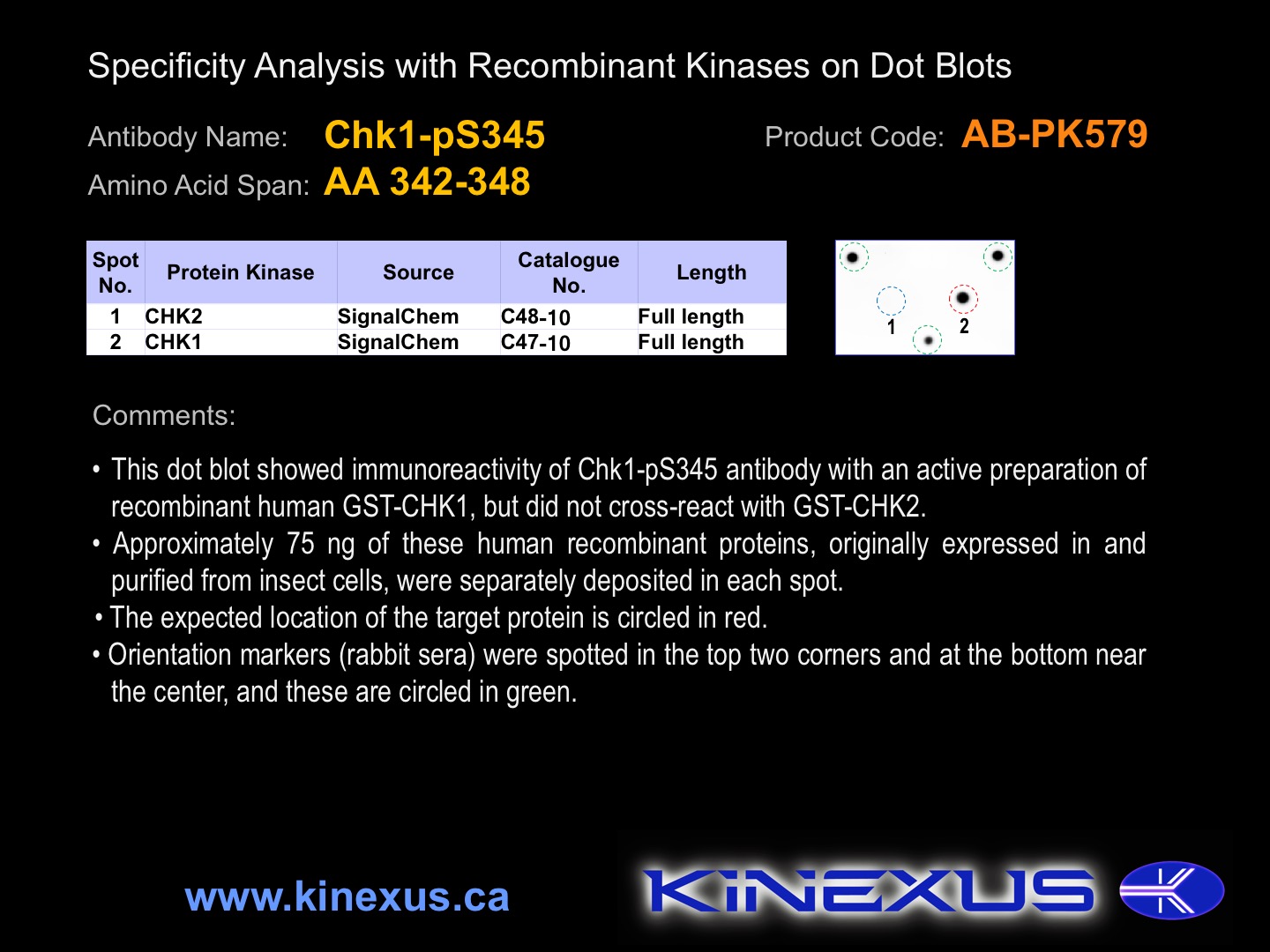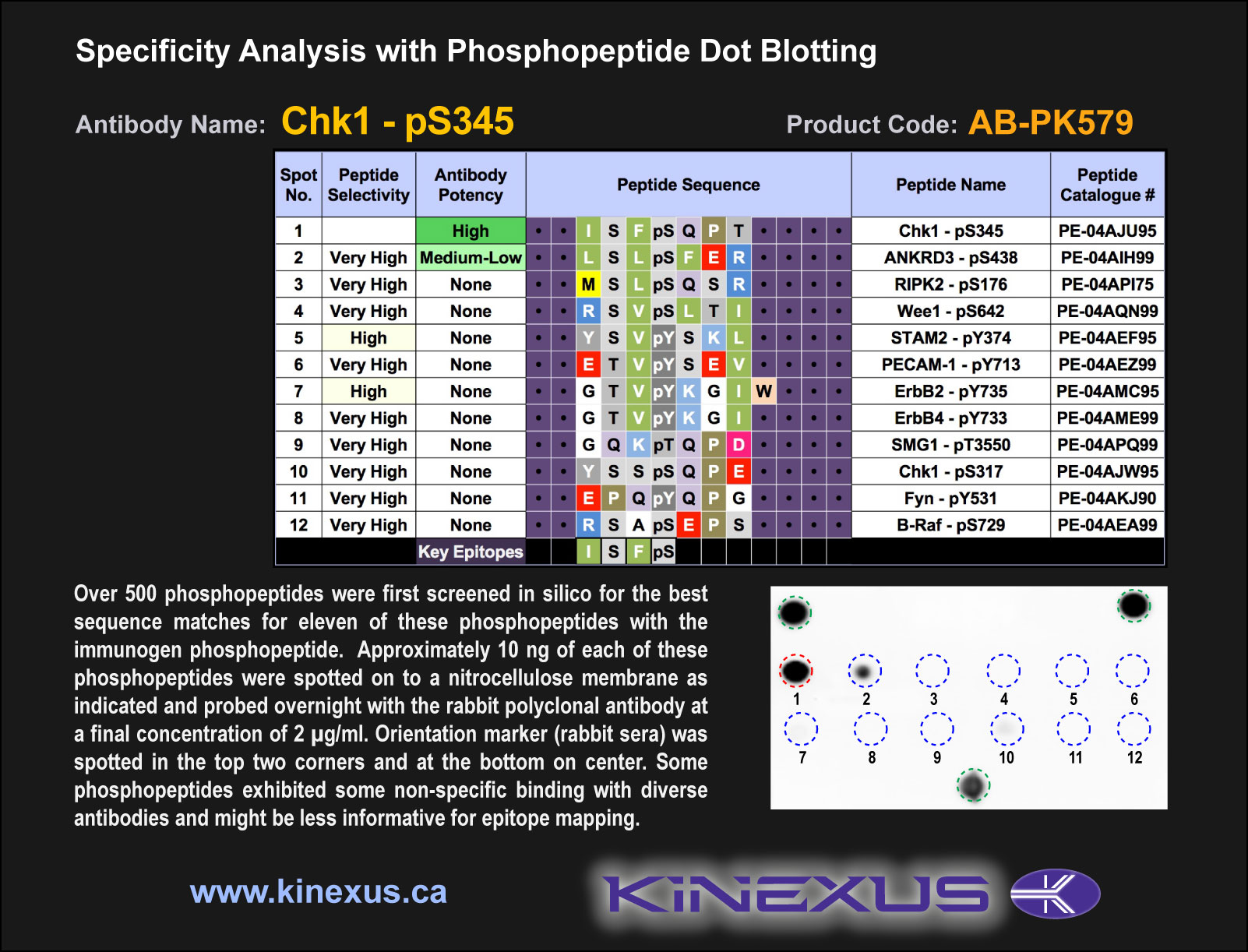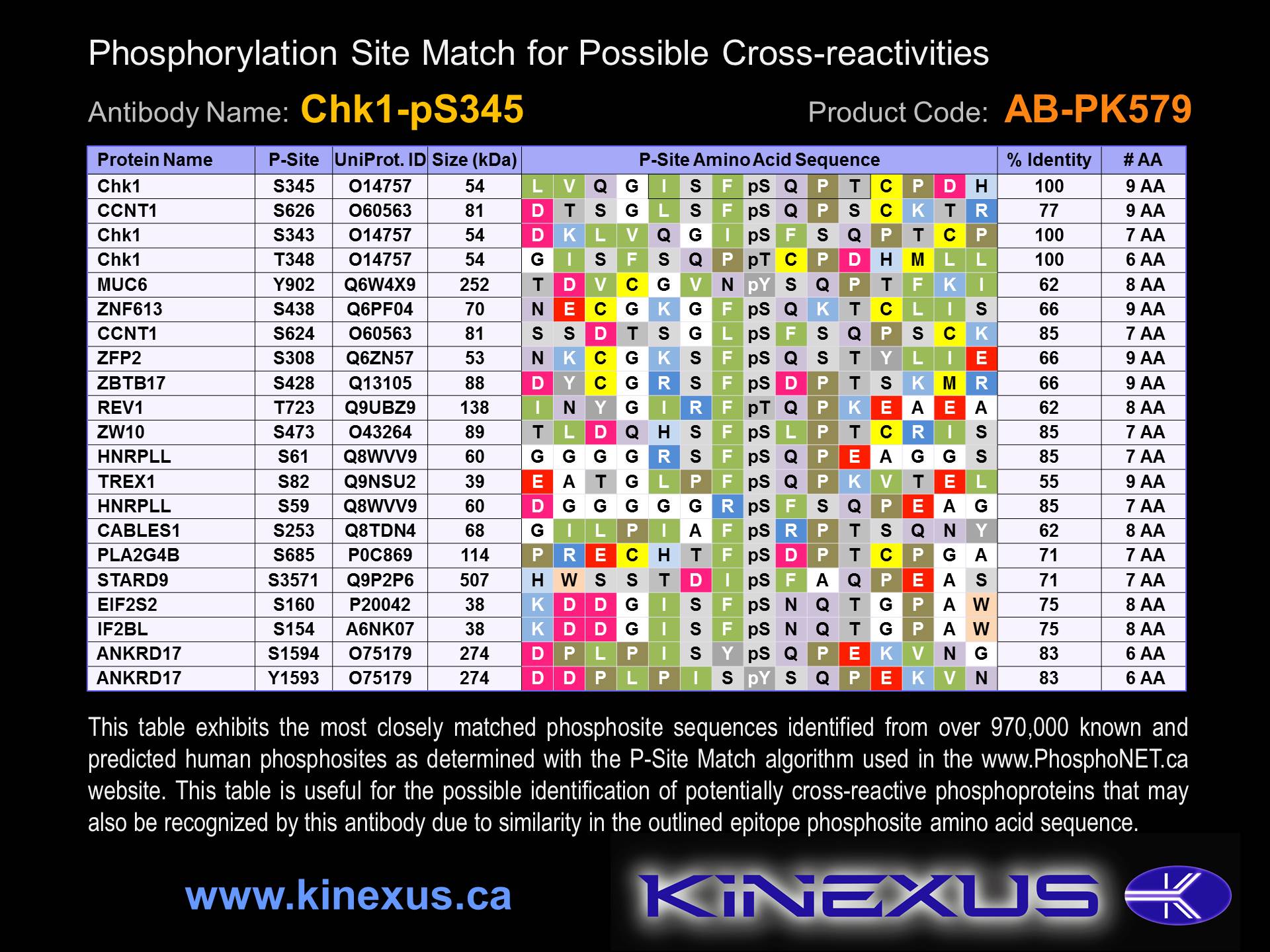Product Name: Chk1-pS345
Product Number: AB-PK579
| Size: | 25 µg | Price: | 89.00 | |
| $US |
Target Full Name: Checkpoint protein-serine kinase 1
Target Alias: CHEK1; CCDS8459.1; ENSG00000149554
Product Type Specific: Protein kinase phosphosite-specific antibody
Antibody Code: PK579
Antibody Target Type: Phosphosite-specific
Antibody Phosphosite: S345
Protein UniProt: O14757
Protein SigNET: O14757
Antibody Type: Polyclonal
Antibody Host Species: Rabbit
Antibody Immunogen Source: Human Chk1 (CHEK1) sequence peptide Cat. No.: PE-04AJU95
Target Alias: CHEK1; CCDS8459.1; ENSG00000149554
Product Type Specific: Protein kinase phosphosite-specific antibody
Antibody Code: PK579
Antibody Target Type: Phosphosite-specific
Antibody Phosphosite: S345
Protein UniProt: O14757
Protein SigNET: O14757
Antibody Type: Polyclonal
Antibody Host Species: Rabbit
Antibody Immunogen Source: Human Chk1 (CHEK1) sequence peptide Cat. No.: PE-04AJU95
Antibody Immunogen Sequence: ISF(pS)QPT(bA)C
Antibody Immunogen Description: Corresponds to amino acid residues I342 to T348; In the C-terminal half of the kinase after the catalytic domain
Antibody Immunogen Description: Corresponds to amino acid residues I342 to T348; In the C-terminal half of the kinase after the catalytic domain
Production Method: The immunizing peptide was produced by solid phase synthesis on a multipep peptide synthesizer and purified by reverse-phase hplc chromatography. Purity was assessed by analytical hplc and the amino acid sequence confirmed by mass spectrometry analysis. This peptide was coupled to KLH prior to immunization into rabbits. New Zealand White rabbits were subcutaneously injected with KLH-coupled immunizing peptide every 4 weeks for 4 months. The sera from these animals was applied onto an agarose column to which the immunogen peptide was thio-linked. Antibody was eluted from the column with 0.1 M glycine, pH 2.5. Subsequently, the antibody solution was neutralized to pH 7.0 with saturated Tris.This antibody was also subject to negative purification over phosphotyrosine-agarose.
Antibody Modification: Unconjugated. Contact KInexus if you are interest in having the antibody biotinylated or coupled with fluorescent dyes.
Antibody Modification: Unconjugated. Contact KInexus if you are interest in having the antibody biotinylated or coupled with fluorescent dyes.
Antibody Concentration: 1 mg/ml
Storage Buffer: Phosphate buffered saline pH 7.4, 0.05% Thimerasol
Storage Conditions: For long term storage, keep frozen at -40°C or lower. Stock solution can be kept at +4°C for more than 3 months. Avoid repeated freeze-thaw cycles.
Product Use: Western blotting | Antibody microarray
Antibody Dilution Recommended: 2 µg/ml for immunoblotting
Antibody Potency: Very strong immunoreactivity with immunogen peptide on dot blots.
Antibody Species Reactivity: Human
Antibody Positive Control: The observed molecular mass of the processed target protein on SDS-PAGE gels is reported to be around 54-58 kDa.
Storage Buffer: Phosphate buffered saline pH 7.4, 0.05% Thimerasol
Storage Conditions: For long term storage, keep frozen at -40°C or lower. Stock solution can be kept at +4°C for more than 3 months. Avoid repeated freeze-thaw cycles.
Product Use: Western blotting | Antibody microarray
Antibody Dilution Recommended: 2 µg/ml for immunoblotting
Antibody Potency: Very strong immunoreactivity with immunogen peptide on dot blots.
Antibody Species Reactivity: Human
Antibody Positive Control: The observed molecular mass of the processed target protein on SDS-PAGE gels is reported to be around 54-58 kDa.
Antibody Specificity: Very high
Antibody Cross Reactivity: No significant cross-reactive proteins detected in HeLa, MCF7 and T98G cells or in sea star oocytes, except for a weak 78 kDa protein in phorbol ester-treated HeLa cells.
Related Product 1: Chk1-pS345 blocking peptide
Related Product 2: Chk1-pS280 phosphosite-specific antibody (Cat. No.: AB-PK577)
Related Product 3: Chk1-pS317 phosphosite-specific antibody (Cat. No.: AB-PK578)
Related Product 5: Chk1Selectide - Chk1 (CHEK1) protein kinase substrate peptide
Antibody Cross Reactivity: No significant cross-reactive proteins detected in HeLa, MCF7 and T98G cells or in sea star oocytes, except for a weak 78 kDa protein in phorbol ester-treated HeLa cells.
Related Product 1: Chk1-pS345 blocking peptide
Related Product 2: Chk1-pS280 phosphosite-specific antibody (Cat. No.: AB-PK577)
Related Product 3: Chk1-pS317 phosphosite-specific antibody (Cat. No.: AB-PK578)
Related Product 5: Chk1Selectide - Chk1 (CHEK1) protein kinase substrate peptide
Scientific Background: Chk1 (CHEK1) is a protein-serine/threonine kinase of the CAMK group and CAMKL family. It is required for checkpoint-mediated cell cycle arrest. It appears to be a tumour suppressor protein (TSP). The active form of the protein kinase normally acts to inhibit tumour cell proliferation. It activates DNA repair (i.e. homologous recombination) by phosphorylating RAD51 or FANCE in response to the presence of damage or unreplicated DNA. It regulates cell cycle progression via several mechanisms: 1) phosphorylation of certain proteins such as CDC25A, CDC25B and CDC25C, promoting their degradation; 2) phosphorylation and activation of p53; 3) phosphorylation and inactivation of TLK1, which consequently prevents TLK1-dependent phosphorylation of chromatin assembly factor ASF1A; 4) phosphorylation of histones and regulating transcription of genes involved in cell-cycle progression regulation; 5) phosphorylation of RB1 to promote its interaction with E2F transcription factors and subsequent cell cycle arrest. It is nhibited by phosphorylation at S280. S345A mutation of Chk1 leads to reduced phosphorylation and impaired activation to nuclear retention after checkpoint activation. Mutations at 372, 376, and 379 amino acids lead to misfolding and induced binding with ubiquitin.
Figure 1. Dot blotting Chk1-pS345 antibody with recombinant purified proteins.
Figure 2. Epitope mapping of Chk1-pS345 antibody with similar phosphopeptides on dot blots.
© Kinexus Bioinformatics Corporation 2017




